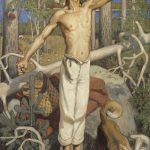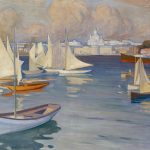
Antti Favén, a Finnish painter renowned for his portraits and landscapes, was born on November 6, 1882, in the city of Hämeenlinna, Finland. His work captured the essence of Finnish society during the early 20th century and contributed significantly to the country’s artistic heritage. This biography delves into Favén’s life, exploring his upbringing, education, artistic journey, and the legacy he left behind.
Early Life and Background
Antti Favén was born into a family with a rich cultural heritage. His father, Alexander Favén, was a well-known architect, and his mother, Alma Favén, came from a family deeply involved in the arts. This environment nurtured Antti’s early interest in art and provided him with the initial exposure to artistic endeavors.
From a young age, Favén exhibited a keen interest in drawing and painting. His family recognized his talent and encouraged him to pursue his passion. As a child, he would often be found sketching scenes from his surroundings, capturing the landscapes and people of Hämeenlinna with remarkable detail.
Education and Early Career
Favén’s formal education in art began at the Drawing School of the Finnish Art Society in Helsinki, where he studied from 1900 to 1904. Here, he was under the tutelage of prominent Finnish artists such as Eero Järnefelt and Helene Schjerfbeck. These mentors played a crucial role in shaping his artistic style and techniques. Järnefelt, known for his realistic landscapes, and Schjerfbeck, recognized for her innovative approach to portraiture, both influenced Favén’s work.

After completing his studies in Finland, Favén continued his education abroad. He traveled to Paris, the epicenter of the art world at the time, to study at the Académie Julian. In Paris, he was exposed to the works of contemporary European artists and the various art movements that were flourishing at the turn of the century. This experience broadened his artistic horizons and introduced him to new styles and techniques.
Artistic Style and Influences
Antti Favén’s artistic style evolved throughout his career, reflecting the influences of his education and the changing trends in the art world. His early works were characterized by a realistic approach, influenced by his mentors in Finland. However, his time in Paris exposed him to Impressionism and Post-Impressionism, which began to permeate his work.
Favén’s portraits are perhaps his most celebrated works. He had a remarkable ability to capture the personality and essence of his subjects, whether they were prominent figures in Finnish society or everyday people. His portraits often featured a subtle interplay of light and shadow, bringing out the depth and complexity of his subjects.

In addition to portraits, Favén was also known for his landscapes. These works often depicted the Finnish countryside, capturing its serene beauty and the changing seasons. His landscapes were marked by a delicate use of color and an attention to detail that brought the scenes to life.
Notable Works and Exhibitions
Throughout his career, Antti Favén created numerous notable works that garnered critical acclaim and solidified his reputation as one of Finland’s leading artists. Some of his most celebrated works include portraits of prominent Finnish figures such as composer Jean Sibelius and author Juhani Aho. These portraits not only captured the likeness of their subjects but also conveyed their inner character and personality.
Favén’s landscapes, such as “Autumn in Häme” and “Winter Evening,” are also highly regarded. These works showcase his ability to depict the natural beauty of Finland with a keen eye for detail and a sensitive use of color.
Favén’s work was regularly exhibited in Finland and abroad. He participated in exhibitions organized by the Finnish Art Society and the Helsinki Art Association. His work was also featured in international exhibitions, including the Paris Salon, where he received positive reviews from critics.
Personal Life
Antti Favén’s personal life was closely intertwined with his artistic career. He married Elina Vaaranen, a fellow artist, in 1910. The couple shared a deep bond and often collaborated on artistic projects. They had two children, both of whom inherited their parents’ artistic talents.

Despite the demands of his career, Favén remained deeply connected to his family. He often found inspiration in his home life and depicted scenes from his domestic surroundings in his work. His family was a source of support and encouragement throughout his life.
Later Years and Legacy
In his later years, Antti Favén continued to paint and exhibit his work, although he gradually retreated from the public eye. He remained active in the Finnish art community, mentoring younger artists and contributing to the development of the country’s artistic heritage.
Favén’s contributions to Finnish art were recognized with numerous honors and awards. In 1947, he was awarded the Pro Finlandia medal, one of the highest honors in Finnish culture. This accolade was a testament to his impact on the country’s artistic landscape.
Antti Favén passed away on May 27, 1948, leaving behind a rich legacy of artistic achievement. His works continue to be celebrated for their technical excellence and emotional depth. Today, his paintings are held in major Finnish art collections, including the Ateneum Art Museum in Helsinki, where they are admired by art enthusiasts and scholars alike.
Antti Favén’s life and career were marked by a deep commitment to his art and a dedication to capturing the essence of Finnish society. From his early years in Hämeenlinna to his studies in Paris and his celebrated career in Finland, Favén’s journey was one of continuous growth and exploration.

His portraits and landscapes remain a testament to his skill and vision, offering a glimpse into the people and places that shaped Finland during the early 20th century. Through his work, Favén has left an indelible mark on the world of art, and his legacy continues to inspire and resonate with future generations.
In understanding Favén’s contribution, one must consider not only his technical prowess but also his ability to convey the human experience through his art. His paintings are not just representations of people and places; they are windows into the emotions, stories, and lives of his subjects. This depth of expression is what sets Favén apart as a master of his craft.
As we reflect on Antti Favén’s life and work, we are reminded of the power of art to transcend time and place, capturing the essence of a moment and preserving it for posterity. His legacy is a rich tapestry of creativity and dedication, woven with the threads of his experiences, influences, and unwavering passion for art.




